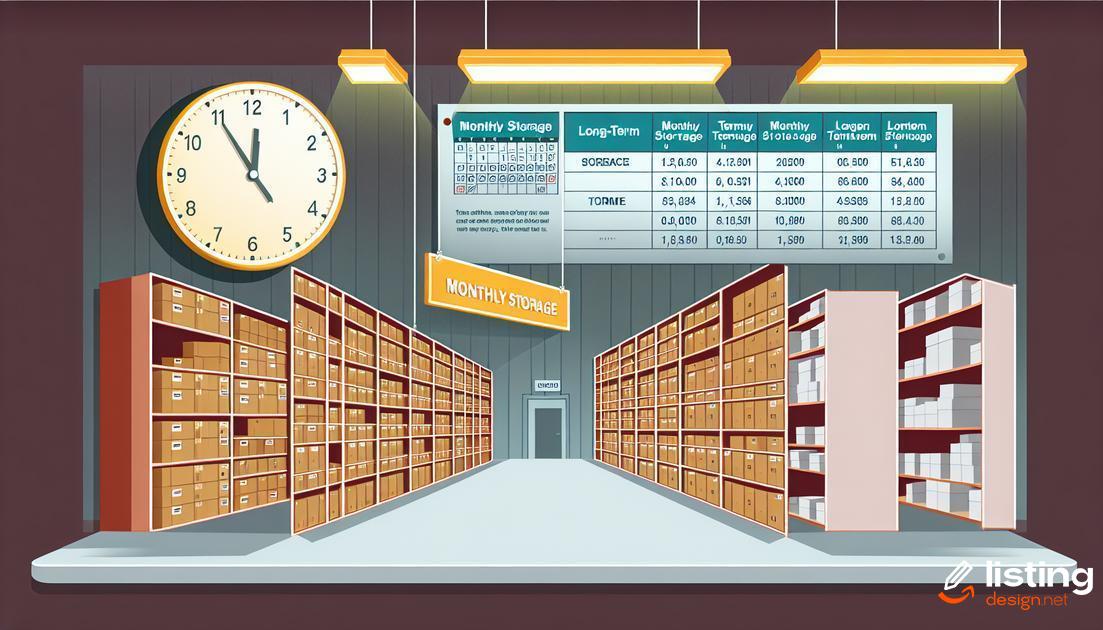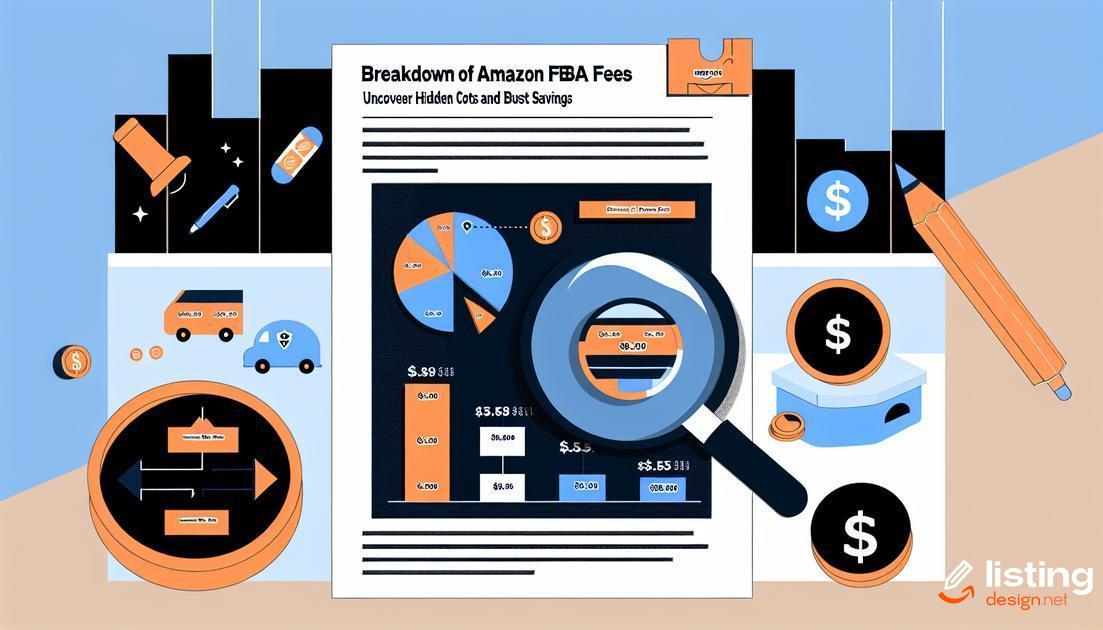Curious about the costs associated with Amazon FBA? Our detailed Amazon FBA fees breakdown will help you understand each fee and discover hidden costs, allowing you to better manage your finances. In this post, we’ll guide you through each type of fee, provide tips on how to minimize them, and share successful case studies to inspire your business strategy.
Table of Contents
Understanding FBA Fees Structure
Amazon FBA (Fulfillment by Amazon) offers a great way to streamline your business, but it’s crucial to understand the fee structure to manage costs effectively. The FBA fee structure consists of multiple components, each impacting your bottom line differently.
The major categories of FBA fees include Fulfillment Fees, Storage Fees, and Referral Fees. Each one has its own subcategories and unique calculations:
Fulfillment Fees
These are charged per unit and cover picking, packing, shipping, and handling of your products. They vary based on the product’s size and weight.
Storage Fees
Monthly Storage Fees are charged per cubic foot and depend on the time of year. Rates are higher during peak seasons like Q4. Long-Term Storage Fees are assessed for items stored in a fulfillment center for more than 365 days, encouraging faster inventory turnover.
Referral Fees
Referral fees are calculated as a percentage of the selling price and vary by category. This fee is Amazon’s commission for facilitating the sale on their marketplace.
By understanding these components, you can better navigate the FBA fees and strategize to reduce costs where possible.
Storage Fees: Monthly and Long-Term

Amazon FBA charges storage fees based on the volume of your inventory stored in their fulfillment centers. These fees are billed monthly and are based on the daily average volume (measured in cubic feet) for the space your inventory occupies.
Monthly storage fees vary depending on the time of year. From January to September, the fees are lower due to lower warehouse demand. From October to December, during the holiday season, fees increase to reflect higher demand for storage space.
Monthly Storage Fees
From January to September, the rates are as follows:
- Standard-size products: $0.75 per cubic foot
- Oversize products: $0.48 per cubic foot
From October to December, the rates increase to:
- Standard-size products: $2.40 per cubic foot
- Oversize products: $1.20 per cubic foot
Long-Term Storage Fees
In addition to monthly storage fees, Amazon also charges long-term storage fees for items stored for more than 365 days. These fees are applied to any inventory that has been in a fulfillment center for over a year.
Long-term storage fees are charged at $6.90 per cubic foot or $0.15 per unit, whichever is greater. Amazon performs an inventory clean-up on the 15th of each month to assess and apply these charges.
It is critical to manage your inventory effectively to avoid long-term storage fees. Regularly review your inventory performance and take action to address slow-moving or excess stock. Strategies such as running promotions or removing unsellable items can help mitigate these additional costs.
Fulfillment Fees Explained
Fulfillment fees are charges that Amazon imposes for picking, packing, and shipping orders to customers. These fees vary based on the size and weight of the item being sold. Standard-size items generally incur lower fees compared to oversized items. The fulfillment fee is calculated per unit, so selling higher volumes can increase the total cost incrementally.
Amazon uses a specific rate card to determine these fees, which is updated periodically. It’s crucial to regularly check Amazon’s pricing changes to ensure accurate cost projections. The rate card is usually categorized by item dimensions and weight brackets.
For example, the fee for a small standard-size item weighing 6 ounces or less might be lower compared to a large standard-size item weighing over a pound. Sellers should consider these variables when setting prices to maintain profitability.
Additionally,
peak season costs
can also influence fulfillment fees. During high-demand periods, such as holidays, Amazon may adjust rates to account for increased operational costs. Therefore, planning inventory and sales strategies around these seasons is important.
Understanding detailed costs associated with Amazon’s fulfillment services helps sellers make informed decisions and potentially find cost-saving opportunities. Using the provided tools and calculators on Amazon’s Seller Central can also assist in predicting and managing these fees effectively.
Referral Fees and How They Are Calculated

Referral fees are one of the significant costs associated with selling products on Amazon FBA. These fees are charged as a percentage of the total sales price, which includes the item price, shipping cost, and any gift-wrapping charges. Understanding how referral fees are calculated is crucial for managing your expenses effectively.
Categories play a major role in determining referral fees. Each product category has a different percentage rate, ranging from 6% to 45%. Most common categories, such as electronics and home goods, typically have referral fees around 15%. However, some categories like Amazon Device Accessories can have a lower fee, while jewelry and fine arts might have higher percentages.
Amazon also sets a minimum referral fee for some categories. For instance, if the calculated referral fee for a product is less than the minimum fee, the seller has to pay the pre-defined minimum fee. This ensures Amazon covers their operational costs regardless of the product price.
Another important aspect is the referral fee discount that sellers can take advantage of. During specific promotional periods or special events, Amazon might provide referral fee discounts for certain categories. Keeping an eye on these promotions can help in reducing overall selling costs.
Finally, special fee considerations are given to products sold globally. If selling in multiple marketplaces, different referral fees might apply depending on the local Amazon site and its specific category rates. This is vital for international sellers to consider when pricing their products.
Variable Closing Fees Specifics
Variable closing fees are specific charges applied by Amazon on certain product categories. These fees usually affect media items such as books, music, videos, and DVDs. It’s important to know that these fees are added on top of the standard referral fees.
The fee structure varies based on the item type and price. For example, for media products, the variable closing fee could be a flat fee per unit sold.
In addition, electronics and accessories might have a different fee structure. These fees can significantly impact your profitability if not properly accounted for.
Calculating Variable Closing Fees
To calculate the variable closing fees, you should consider both the fixed rate associated with the category and any additional fees depending on the item price. Sellers should keep a close watch on these charges, as they can quickly add up and affect the overall margin.
Always check Amazon’s official fee policies for the most accurate and up-to-date information. Understanding these specifics can help you better manage your inventory and pricing strategy.
Additional Service Fees You Should Know

Amazon FBA service may come with several additional fees that sellers should be aware of to avoid unexpected charges. Labeling Service Fees are applied when Amazon labels your products for you, which can be handy but comes at a cost. Prep Service Fees might also be incurred for products that need specific preparation, like polybagging or bubble wrapping before they are shipped. Returns Processing Fees are another charge to consider, especially if you sell consumer electronics or other high-return items. These fees cover the cost of handling customer returns. If you choose Amazon’s disposal services for unsellable inventory, be prepared for Disposal Fees as well. Lastly, there are Inventory Placement Service Fees for those who prefer to send all inventory to one fulfillment center and have Amazon redistribute it nationwide. Understanding and considering these additional service fees can significantly impact your FBA cost management strategy.
Tips to Minimize FBA Fees
One of the most effective ways to minimize FBA fees is through efficient inventory management. Regularly monitor your stock levels and avoid overstocking items that don’t sell quickly. This helps in reducing long-term storage fees, which can add up significantly over time.
Using Amazon’s Inventory Performance Index can guide you in maintaining an optimal level of inventory, thus lowering your overall costs. Additionally, consider off-season storage options for products that aren’t in demand year-round.
Utilize Amazon’s labeling services judiciously. Labeling fees can be avoided if you handle this process yourself, ensuring your products are ready for FBA centers without incurring extra costs.
Bundling products can also reduce fees. By combining related items into one package, you can move slow-moving inventory faster and reduce individual fulfillment fees. This strategy can be particularly effective during holiday seasons when shoppers are looking for gift sets or combos.
Opt for the right-sized packaging. Using the appropriate level of packaging prevents additional dimensional weight charges, which can be unnecessarily costly. Always check Amazon’s packaging requirements to ensure compliance without incurring extra fees.
Another way to lower fees is through direct shipments to nearby fulfillment centers. Sending products closer to their primary selling regions cuts down on transportation fees and improves delivery times.
Lastly, consider negotiating with manufacturers for better prices or shipping terms. Lowering your cost of goods can give you more flexibility in managing and offsetting FBA-related expenses.
Consistently reviewing and adjusting your pricing strategy to remain competitive while covering all relevant fees can also help in maintaining profitability without burdening your business with excess costs.
Case Studies: Successful Cost Management

Amazon’s FBA case studies often reveal insightful tactics for effective cost management. One notable example involves a small business that managed to reduce its fulfillment fees by optimizing their packaging process. By adjusting the size of their product packaging, they decreased the overall weight and dimensions, leading to substantial savings on shipping costs.
Another success story comes from a mid-sized retailer who leveraged long-term storage fee awareness. By tracking inventory and removing slow-selling items before the six-month mark, they avoided hefty long-term storage fees. This proactive approach not only saved money but also improved inventory turnover, directly impacting their bottom line.
A third case involves a niche e-commerce seller who meticulously analyzed referral fees across different product categories. By focusing on high-margin products with lower referral fees, they maximized their profit margins. Additionally, they used Amazon’s promotional tools to boost sales volume in these categories, further enhancing their cost efficiency.
These examples underline the importance of a thoughtful and strategic approach to managing FBA fees. By carefully analyzing cost components and implementing targeted adjustments, businesses can significantly improve their profitability on the Amazon platform.


